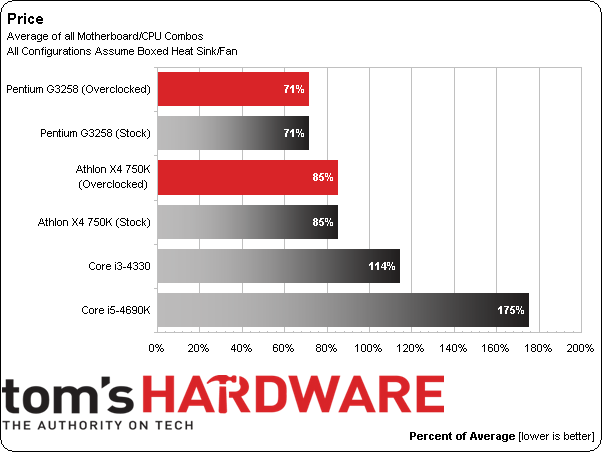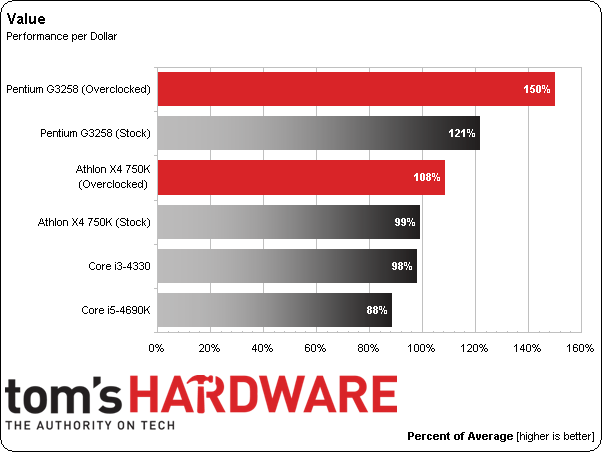The Pentium G3258 Cheap Overclocking Experiment
You wanted a comparison of Intel's Pentium G3258 using low-cost platform components. Can an entry-level motherboard and bundled heat sink still deliver a satisfying overclocking experience, or does going cheap ruin this dual-core CPU's value appeal?
Performance, Price and Value
If you made it through page 16 of Intel Pentium G3258 CPU Review: Haswell, Unlocked, For $75, then you already know how Intel’s Pentium G3258 and AMD’s Athlon X4 750K size up against each other in a log of power consumption through our entire benchmark suite. At the very end of it all, we determined that an overclocked Pentium’s efficiency is fairly remarkable, while an overclocked Athlon X4 750K does well enough to beat a stock Pentium.
The focus this time around is comparing both of those chips using stripped-down platforms more akin to what an enthusiast on a budget might look for, so considering value becomes important.
Let’s start with a measure of speed. We average together each CPU’s performance in our gaming, media encoding, content creation, productivity, and file compression sub-suites, making those averages our baselines. The processors are individually compared to the baseline, and then averaged across the suites, yielding a relative performance percentage.
Naturally, in a collection of tests biased toward multi-core optimizations, a CPU like Intel’s Core i5-4690K is going to finish in the lead. And by no small margin, either. The Core i3-4330 staves off the Pentium, demonstrating a clear benefit of Hyper-Threading technology as it maximizes core utilization. From there, only an overclocked Pentium G3258 can keep its nose above the performance baseline so clearly skewed by a fast Core i5. The overclocked AMD Athlon X4 750K lands under at 92%, though that’s enough to beat a stock Pentium G3258.
Now, we look at the price of our platforms, including motherboard, processor, and cooler. Everything else is constant from one test setup to the next. Obviously, as you add more hardware to the total system price, differences between them are diluted, so we're only adding up variables.
It surprised us to see Intel price the unlocked Pentium at just $70, $10 under AMD’s competing Athlon X4 750K. But, at least initially, expensive Z97 and Z87 motherboards wrecked any advantage Intel might have enjoyed.
With the advent of overclocking-capable H81, B85, and H87 boards, though, platform cost dropped. Using the products recommended by MSI for entry-level builders, our combination of Intel parts is actually cheaper than the AMD package. That’s why you see the Pentium appear at the top of this chart, followed by AMD’s Athlon X4 750K.
Get Tom's Hardware's best news and in-depth reviews, straight to your inbox.
Intel asks quite a bit more for the Core i3 and Core i5, so even if we assume the same motherboard price and give credit for a free heat sink, those two chips land at the bottom of our pricing average.
Dividing performance by price yields a value number for each platform. Higher performance and a lower price hand Intel’s overclocked Pentium G3258 a commanding lead, which is followed by the same Pentium at its stock clock rate. AMD’s overclocked Athlon X4 750K lands in third place, while the stock Athlon barely beats out Intel’s Core i3-4330.
Despite its overwhelming performance advantage, a big price tag penalizes the Core i5-4690K. Many enthusiasts won’t care, preferring to spend more money on a faster CPU for its greater utility in many applications. We totally get that, and would do the same if budget allowed.
Let’s Try That Again
We were happy to take MSI’s guidance on motherboards with overclocking chops at reasonable prices. But for the sake of argument, let’s say you were able to find a Socket FM2+ motherboard for the same price as the H81M-P33 we used, and that it overclocked just as well as our A78M-E35. How would the calculations change?
The outcome wouldn’t change in our performance chart, of course.
Pricing would, though. Because AMD still charges more for its Athlon X4 750K, Intel’s Pentium gets to keep its lead. Meanwhile, the Core i3 and i5 look even worse in the face of cheaper competition. That is to say, the average moves toward lower pricing.
Matching motherboard prices cuts into the Pentium’s advantage a little bit. However, the stock G3258 holds onto its second-place finish behind the Pentium at 4.4 GHz. AMD’s overclocked Athlon nearly ties for second, though, and the stock AMD processor extends its value lead over the Core i3.
Current page: Performance, Price and Value
Prev Page Results: Real-World Benchmarks Next Page Our Pentium Experiment: Recalibrating For Value-
Someone Somewhere First page (in bold heading):Reply
Wait, Did You Say B81?
You mean either H81 or B85, I'm guessing. -
vertexx Are you seriously running the Athlon on DDR3-1600 RAM? Please confirm as it's too difficult to be sure with all of the ridiculous adware you have baked into this article.Reply -
LucoTF Reply13828161 said:First page (in bold heading):
Wait, Did You Say B81?
You mean either H81 or B85, I'm guessing.
LOL
they were offered both and settled on the H81 -
tomfreak U guys should throw in Core 2 quad 9550/9650 and bench together or even the Nehelem quad core to compare.Reply -
cangelini @ Nuckles_56: the modules we used came from one standardized kit. Because the H81 and A78 platforms only offer two slots, we pulled two modules from the kit. The other boards gave us four slots, so we used four modules from the same kit. On an X79- based board, you'd see all eight in play.Reply -
Traciatim @TomFreak, Tom's have already done an old vs new article that tested the core2duo and Quad vs newer i3's an i5's. No reason to redo the tests since you can pretty much extrapolate about where your performance would sit if you look over both articles. Bottom line is it's probably not worth going from a Core2Quad that overclocks pretty reliably to an i3 or Pentium, but in most cases the i3 and newest unclocked Pentium would perform slightly better and use less power.Reply
http://www.tomshardware.com/reviews/ivy-bridge-wolfdale-yorkfield-comparison,3487-9.html
-
bdiddytampa If you are in the US and are close to a Microcenter, they offer a G3258 and MSI Z97 board bundle for $99. Killer deal for a cheap starter system.Reply






